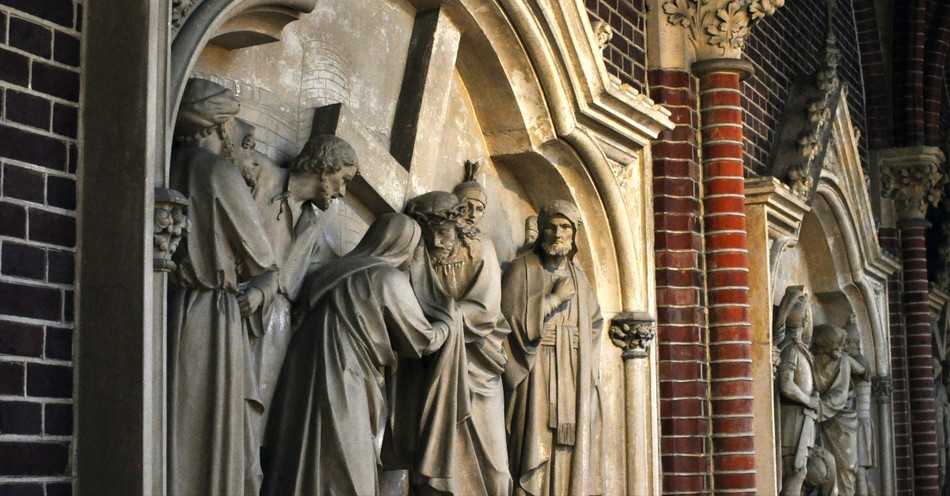For centuries, Roman Catholic believers have celebrated the Stations of the Cross, or Way of the Cross, usually the week before Easter. The Stations of the Cross refer both to a series of depictions of Christ’s journey from the court of Pontius Pilate to the tomb and to a short pilgrimage centered around these stations.
Though the Stations of the Cross or Via Crucis is typically associated with Catholicism, some Protestant churches also participate in this or a modified version of the practice. Though certain denominations may not agree with all parts of the Stations of the Cross, there are truths to be gleaned from this practice for any believer, reminding us of Jesus’ death and sacrifice to save us from sin and redeem us.
Table of Contents
- What Are the Stations of the Cross?
- Simple Stations of the Cross
- Stations of the Cross Prayers
- 14 Bible Verses for Stations of the Cross
- Origin of the Stations
- Biblical Accuracy of Stations
- What Is the Purpose of the Stations of the Cross?
- Importance of the Stations of the Cross
What Are the Stations of the Cross?
Though the stations of the cross and the number of stations has varied throughout history and between Catholic and Protestant practice, the typical version consists of 14 stations. Those stations are as follows:
- Christ is condemned to death.
- The cross is laid upon Him.
- Jesus falls.
- Christ meets His mother, Mary.
- Simon of Cyrene is made to bear the cross.
- Veronica wipes Christ’s face.
- Jesus falls a second time.
- The women of Jerusalem weep over Jesus.
- Jesus falls a third time.
- Christ is stripped of His garments.
- Christ is crucified.
- Jesus dies on the cross.
- His body is taken down from the cross.
- He is laid in the tomb.
As objects, the stations may be made of sculpted or carved stone, wood, or metal, or they may be paintings or engravings. Usually, these are arranged around a church or cathedral, but sometimes they’re arranged along roads leading to a church or shrine.
Simple Stations of the Cross
Alternate stations are sometimes used to stick more closely to the biblical narrative. These versions only include events that are actually recorded in the Bible. A common simplified version of the stations of the cross has eight stations:
- Pilate condemns Jesus to die.
- Jesus accepts His cross.
- Simon helps carry the cross.
- Jesus speaks to the women.
- Jesus is stripped of His garments.
- Jesus is nailed to the cross.
- Jesus dies on the cross.
- He is laid in the tomb.
Other Protestant versions maintain 14 stations, but they are different than the Catholic version.
Stations of the Cross Prayers
As you contemplate Christ's sacrifice and each step he took toward the cross for us, here are prayers to thank Him for and reflect on the eight simplified stations of the cross:
Dear Lord, as we meditate on the painful moment when Pilate, influenced by the voices of the crowd, condemned You to die on the cross, we thank you that in the face of false accusations and worldly pressures, You remained silent, accepting the unjust sentence for our salvation. Give us the strength to endure in times of injustice, to stand firm in our faith, and to trust in Your divine plan. Let us learn from Your example of humility and submission, even in the face of suffering. We offer this prayer in Your holy name, Amen.
Heavenly Son, as we contemplate how You willingly accepted the heavy burden of the cross, we are amazed at Your love for us. Thank you for carrying the weight of our sins with steadfast determination. Grant us the grace to accept the crosses in our lives, knowing that through our trials, we can go grow closer to You. In Your precious name, Amen.
Lord Jesus, as we reflect on the moment when Simon of Cyrene helped You carry the heavy burden of the cross, we recognize the unexpected assistance that entered Your journey to Calvary. In this station, we see an example of selfless compassion and shared suffering. Simon, a bystander, became a participant in Your redemptive sacrifice. Help us to be open to helping others carry their burdens, even when it feels inconvenient. Open our eyes to the opportunities for compassion in our daily lives and open our minds to the call to be Simon for those in need. In Your holy name, amen.
Dear Lord, as we ponder when You spoke to the women along the way to Calvary, we are moved by Your compassion even in the midst of Your own suffering. In Your words, we find solace and guidance, a reminder that Your love extends to all. Grant us the grace to hear Your voice in the midst of our challenges, and to respond with faith and trust in Your sacred plan. May we, like the women on that sorrowful journey, be drawn closer to You and find strength in Your words of comfort. In Your precious name, Amen.
Lord Jesus, as we meditate on the moment when You were stripped of Your garments, we are reminded of Your profound vulnerability and humility. You surrendered your dignity, bearing our shame for the sake of our redemption. May we find courage in vulnerability and strength in surrender, trusting that, like You, we will be clothed in the glory of Your grace. We offer this prayer in Your name, the One who bore our shame, Amen.
Jesus, as we contemplate the moment when You were nailed to the cross, we stand in awe of Your immense love and sacrifice. Help us to see the depth of Your love in every trial we endure, and may we find strength in the knowledge that You are with us in our pain. Let the cross be a reminder of Your victory over sin and death, and may we live our lives in gratitude for the salvation You have won for us. Thank you, Amen.
Lord Jesus, as we stand before the Cross where You breathed Your last, we are humbled by the enormity of Your sacrifice for our salvation. As we contemplate Your death, may it not be in vain. Help us to carry the message of Your love and salvation to the world. Lord, by Your wounds, we are healed. May Your sacrifice be our source of hope and inspiration. We offer this prayer in Your name, our Savior and Redeemer, Amen.
Dear Lord, as we come to the end of the Stations of the Cross, we stand in solemn contemplation before the sealed tomb where Your body was laid. As we wait in hope, may the knowledge of Your victory over death inspire us. Help us to live in the light of Your resurrection, embracing the hope that springs from the tomb. We pray this in Your name, our risen Savior, Jesus, Amen.
14 Bible Verses for Stations of the Cross
Matthew 27:22-23 - "Pilate said to them, 'Then what shall I do with Jesus who is called Christ?' They all said, 'Let him be crucified!' And he said, 'Why? What evil has he done?' But they shouted all the more, 'Let him be crucified!'"
Matthew 16:24 - "Then Jesus told his disciples, 'If anyone would come after me, let him deny himself and take up his cross and follow me.'"
Isaiah 53:4-5 - "Surely he has borne our griefs and carried our sorrows; yet we esteemed him stricken, smitten by God, and afflicted. But he was pierced for our transgressions; he was crushed for our iniquities; upon him was the chastisement that brought us peace, and with his wounds, we are healed."
Luke 2:34-35 - "And Simeon blessed them and said to Mary his mother, 'Behold, this child is appointed for the fall and rising of many in Israel, and for a sign that is opposed (and a sword will pierce through your own soul also), so that thoughts from many hearts may be revealed.'"
Mark 15:21 - "And they compelled a passerby, Simon of Cyrene, who was coming in from the country, the father of Alexander and Rufus, to carry his cross."
Isaiah 53:3 - "He was despised and rejected by men, a man of sorrows and acquainted with grief; and as one from whom men hide their faces he was despised, and we esteemed him not."
Psalm 37:23-24 - "The steps of a man are established by the Lord, when he delights in his way; though he fall, he shall not be cast headlong, for the Lord upholds his hand."
Luke 23:27-31 - "And there followed him a great multitude of the people and of women who were mourning and lamenting for him. But turning to them, Jesus said, 'Daughters of Jerusalem, do not weep for me, but weep for yourselves and for your children.'"
Hebrews 4:15 - "For we do not have a high priest who is unable to sympathize with our weaknesses, but one who in every respect has been tempted as we are, yet without sin."
Matthew 27:35 - "And when they had crucified him, they divided his garments among them by casting lots."
Colossians 2:14 - "By canceling the record of debt that stood against us with its legal demands. This he set aside, nailing it to the cross."
Luke 23:46 - "Then Jesus, calling out with a loud voice, said, 'Father, into your hands, I commit my spirit!' And having said this, he breathed his last."
John 19:38 - "After these things, Joseph of Arimathea, who was a disciple of Jesus, but secretly for fear of the Jews, asked Pilate that he might take away the body of Jesus, and Pilate gave him permission."
Matthew 27:59-60 - "And Joseph took the body and wrapped it in a clean linen shroud and laid it in his own new tomb, which he had cut in the rock. And he rolled a great stone to the entrance of the tomb and went away."
Origin of the Stations
The practice of visiting each station to pray originated with early Christian pilgrims who visited the historic sites of the events and walked the route believed to be from Pilate’s house to Christ’s tomb.
The routes that were taken varied at first, due to different interpretations of the route Christ took, but the path known as the Via Dolorosa eventually solidified as beginning at Antonia Fortress in Jerusalem, which was believed to be where Jesus stood before Pilate, to the crucifixion hill of Calvary/Golgotha, and ending at the Basilica of the Holy Sepulcher, which had been erected on the supposed site of Christ’s tomb in the fourth century after Constantine’s legalization of Christian worship. In 1342, Franciscan monks were given official custody of the sites.
Most medieval pilgrims, however, couldn’t afford the arduous journey to the Holy Land. Thus, stations were set up near churches instead. Some Vias Dolorosa were even measured to use the actual distances from the Holy Land between markers. The number of stations varied until Pope Clement XII set the number at 14 in 1731.
A succinct but more thorough account of the history of the practice from Baylor University’s Center for Christian Ethics can be found here.
Biblical Accuracy of Stations
One may very well be confused upon reading the list of the 14 stations for the first time, wondering where exactly those events are in the Bible. Perhaps most noticeably, who is Veronica?
Some of these stations were added due to tradition or legend, not because of anything actually mentioned in the Bible. For example, Veronica is the name of a Roman Catholic saint. Legend has it that as Christ was walking to Calvary, this woman offered him her veil to wipe the sweat and blood from his face, and thus the image of his face was imprinted on the cloth.
The first known mention of this cloth was in the eighth century, 700 years later, in the hands of Pope John VII. The veil and legends became popular in the 13th through 15th centuries when people performed devotions in front of it to receive indulgences. (Learn more here.)
Due to situations such as this one, Protestants are often wary of associating with the stations of the cross. Not only is Veronica not mentioned, none of the four crucifixion accounts in the gospels record Jesus falling on the way (and certainly not three times), nor do they record Him meeting His mother, though it is recorded that He saw His mother once He was already on the cross (John 19:25-27).
Protestants furthermore historically distanced themselves from the stations because of their ties with indulgences, the Roman Catholic teaching that the church has the power to grant, under certain conditions, for certain actions, the remission of temporal punishment for sin.
What Is the Purpose of the Stations of the Cross?
According to the Catholic Online Encyclopedia, “The object of the Stations is to help the faithful to make in spirit, as it were, a pilgrimage to the chief scenes of Christ's sufferings and death.”
Most simply, the stations of the cross, usually performed during Lent, especially on Good Friday, are about remembering Christ’s suffering for our sake. This is evidenced by the typical Catholic prayer uttered at each station:
Guide: We adore you O Christ and we praise you,
All: Because by your holy Cross you have redeemed the world.
During medieval times, a complicated system of indulgences (payment for the forgiveness of sins) became associated with the stations, and thus this was also a good way for worshippers to pursue indulgences.
Importance of the Stations of the Cross
Though the stations of the cross shouldn’t be used to gain forgiveness or be construed as actually participating in Christ’s suffering, they can offer important spiritual reminders.
During Easter, it’s exciting to celebrate Christ’s resurrection. However, the stations of the cross can remind us just how far Jesus went to save us, and what a miracle it truly is that He rose from the grave.
Taking time to think, pray, and meditate at each station can help us intentionally spend time with Christ, thanking Him, praising Him, and learning from Him.
The important parts of the stations of the cross are not the ritual prayers, the placement of stations, or even what stations exactly are included. The most important part is remembering Jesus’ love, sacrifice, and forgiveness and drawing near to Him.
Photo Credit: Fourth and fifth stations of the cross carvings in a church in Sittard, Netherlands. ©iStock/Getty Images Plus/debbiehelbing










